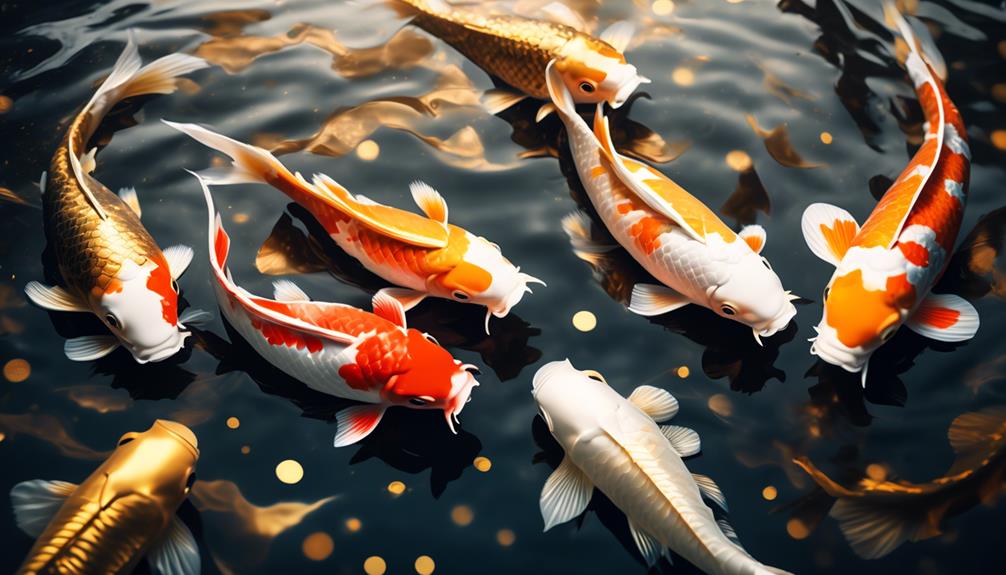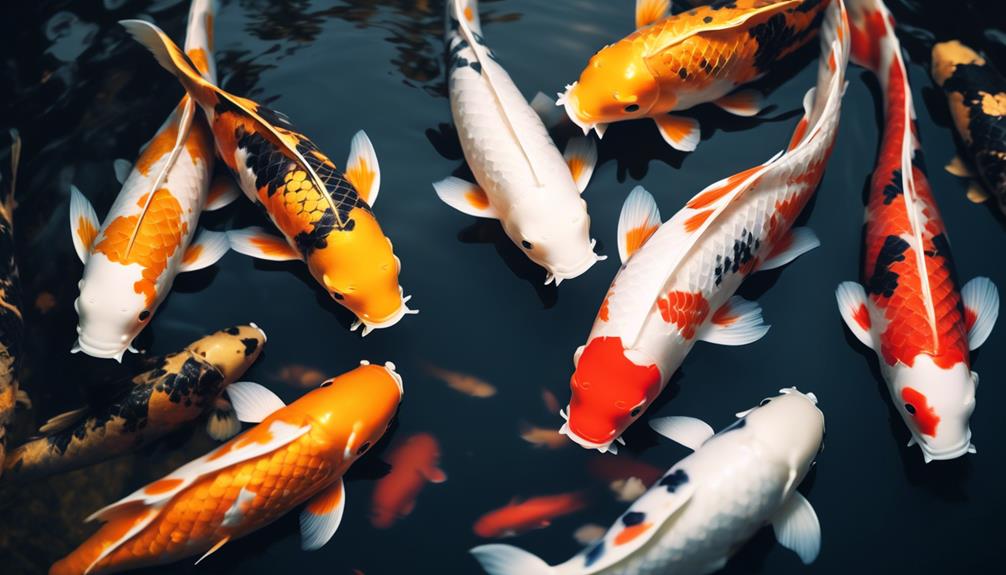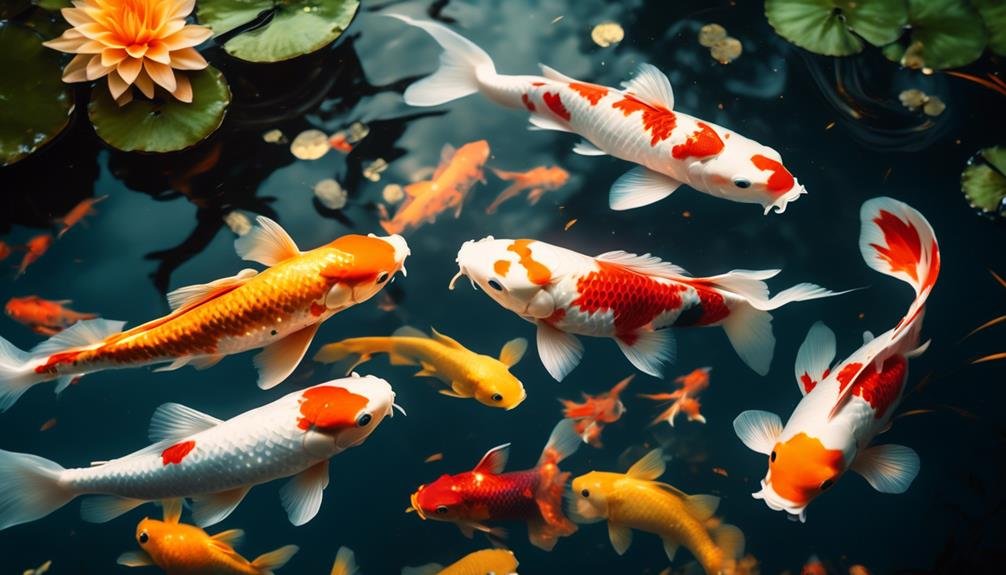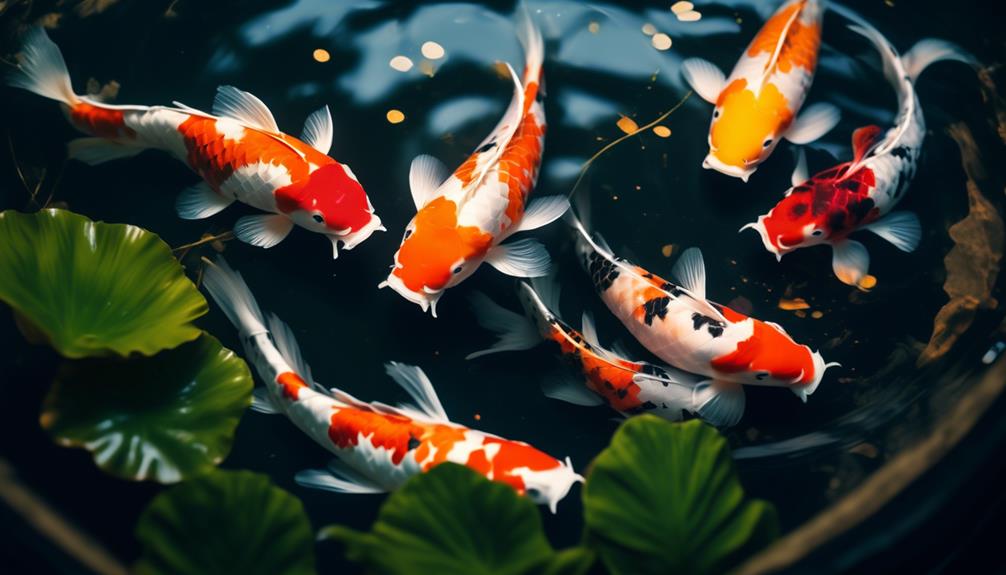Koi enthusiasts greatly admire Hariwake koi for their bright, contrasting colors. These koi are a result of careful breeding, which combines precision and patience to produce fish that resemble living art. They stand out with their shiny skin and bold color spots, attracting both experienced collectors and beginners. This talk will go into detail about Hariwake koi, including where they come from, how their color and patterns matter, and the effort needed to raise them well. Through understanding koi cultivation, it becomes clear that Hariwake koi are special and deserve more attention for their unique beauty.
Hariwake koi have a shiny, metallic look that sets them apart. Their name comes from the Japanese words for 'gold' and 'shining,' which describes their shiny white skin with patches of gold or yellow. Breeders need to be very patient and skilled to get these colors just right, which is why Hariwake koi are so special.
The color and pattern of Hariwake koi are important because they show the fish's quality and the breeder's skill. For example, a top-quality Hariwake should have a bright, clear pattern without any blemishes. The edges of the colored patches should be sharp against the white background. Getting such clarity takes a lot of work, including choosing the right parents and raising the koi in excellent water conditions.
Raising Hariwake koi to their full potential is a challenge. They need clean water, proper nutrition, and protection from diseases. For beginners, it's helpful to start with a well-made pond and reliable filter system. Also, feeding the koi high-quality food that's rich in vitamins can help their colors stay bright. It's important to keep an eye on the water's quality and test it regularly. If problems arise, it's better to ask for advice from more experienced koi keepers or professionals.
In conclusion, Hariwake koi are more than just pond fish; they are the highlight in the world of koi. Their unique beauty comes from the hard work and dedication of the breeders. When you understand what it takes to look after these koi, you appreciate them even more.
Key Takeaways
The Hariwake koi fish, known for its bright white and either orange or yellow markings, is a testament to the skills of koi breeders. Understanding their unique coloration and scale variations is key to recognizing their beauty. These fish need proper care to maintain their health and vivid colors, which includes disease prevention and creating an appropriate pond environment. With the right attention, Hariwake koi can be a stunning addition to any aquatic collection.
To ensure they thrive, it's crucial to provide them with clean water, a balanced diet, and protect them from harsh weather. A well-designed pond with a good filtration system helps keep their environment ideal. Additionally, regular checks for signs of illness will help keep them vibrant and active. For anyone passionate about koi, investing in the well-being of Hariwake koi is rewarding, as they will enhance the visual appeal of your pond with their striking presence.
Understanding Hariwake Koi
To really get to know Hariwake Koi, you need to look closely at their special colors. They stand out because they have a shiny, almost mirror-like white or silver base color. On top of that, they have bright yellow or orange spots. The scales of Hariwake Koi have a sparkle to them that catches your eye. When these koi don't have scales, they're called Doitsu Hariwake. These fish are even more valued because their smooth skin makes their patterns really pop. For a Hariwake Koi to be considered one of the best, its white color should be crisp and even, and the yellow or orange spots should be placed nicely and look good to the eye.
When you're looking at these Koi, it's not just about how bright they are. The whiteness of their bodies is important because it shows off the colors on top. Think of it like a clean canvas that allows the artist's colors to really shine. The way the colors are spread out matters too. If you imagine a painting, the balance of colors can make or break the whole piece. It's the same with these fish—their patterns should look natural and pleasing.
For anyone interested in keeping Hariwake Koi, remember that they're more than just pretty fish. They can bring a certain elegance to your pond, with their glittering scales reflecting the light and creating a peaceful atmosphere. Watching them glide through the water can be quite calming, making them a great choice for someone looking to add both beauty and tranquility to their outdoor space.
The Unique Color Pattern
The beauty of Hariwake Koi fish comes from their bright white color and the distinct yellow or orange spots. These spots, called 'hi', are a key feature and are judged on how clear and evenly they are spread out on the fish. For example, a top-quality Hariwake will have a shiny white background and 'hi' that look like they've been painted on with precision.
Let's break it down simply:
- Base Color: Think of this as the canvas of the fish, which should be a shiny white.
- Markings ('hi'): These are the colorful spots that should be a deep yellow or orange.
- Pattern Balance: The spots should be spread out in a way that looks good and is even.
Why are these features important? The base color sets the stage for the 'hi', which are the main attraction. These spots draw your eye and their placement can make the fish look balanced and more appealing.
For a smooth transition from one point to another, imagine the fish as a piece of art. The white base is the paper, the 'hi' the paint, and the pattern balance how the paint is applied. A Koi with a striking pattern is like a well-painted picture, it catches your attention and holds it.
In writing, we aim for clarity and engagement, much like how a beautifully patterned Hariwake captivates its audience. We use active voice to keep things lively, just as the shimmering scales of the Koi bring it to life. And just like each spot on a Hariwake is intentional, we use transitions thoughtfully to ensure a natural flow of ideas.
To sum it up, a Hariwake Koi with a harmonious pattern and bright colors is a treasure in the world of Koi. It's not just a fish; it's an art form that Koi lovers take great joy in.
Scale Variations Explained

The Doitsu Hariwake Koi fish is known for its scaleless body, which gives it a sleek look. This type stands out due to its smooth skin that makes the bright colors and white background pop.
On the other hand, the Fully Scaled Hariwake is covered in shiny, metallic scales from head to tail. Another kind, the Kin Gin Rin, is special because it has scales that glitter, adding extra shine to its appearance. Platinum Quality refers to scales that are exceptionally shiny, contributing greatly to the fish's overall sparkle. The Matsumo Aoi variety has a distinctive pattern of larger scales spaced apart, resembling a pinecone.
Understanding these different scale types is very important for people who breed Koi fish or are serious about their Koi collections. Knowing the variations helps in picking the right Koi and in taking care of them properly. Each type of scale, whether smooth or glittery, adds its own unique beauty to the Hariwake Koi, making them a prized addition to any pond.
For example, if a breeder wants to create a collection that shines brilliantly under the sunlight, selecting Koi with Kin Gin Rin or Platinum Quality scales would be ideal. Meanwhile, the Doitsu Hariwake would be a perfect choice for someone who appreciates a more streamlined look. It's these details that make each Koi special and a joy to watch as they gracefully swim in their aquatic homes.
Identifying True Hariwakes
To tell if a Koi is a true Hariwake, you should look for two main colors. The fish should have a shiny white base and bright yellow or orange spots. The white should be really shiny, like a mirror, showing that the fish is healthy and comes from good breeding. The yellow or orange should be strong and clearly stand out from the white. True Hariwake Koi won't have any black or red on them. It doesn't matter if the fish has scales or not, as long as these color rules are followed. The lack of other colors proves that the fish is a real Hariwake.
The shiny white color is important because it shows the fish is of high quality. For example, if you see a Koi with a dull white color, it might not be a good Hariwake. The bright yellow or orange colors are also key. They should be easy to spot and not mixed with the white. This makes the fish look more beautiful and shows it's a true Hariwake.
Misconceptions in Naming

It's key to understand what makes a Hariwake Koi unique to avoid mix-ups when classifying these fish. Let's clear up some common naming errors:
- If you see a metallic yellow koi without white, it's not a Hariwake—it's a Yamabuki Ogon.
- Hariwake can have scales or be scaleless (Doitsu); scales don't make a difference.
- A koi with a black, pinecone-like pattern is a Matsuba, not a Hariwake.
- A koi with red and white is called a Kohaku, not a Hariwake.
- Remember, not every koi with two colors is a Hariwake; there are specific traits that define each type.
When we know these differences, we can appreciate the beauty and variety of koi fish even more.
The Value of Scaleless Koi
Scaleless koi, also called Doitsu Hariwake, are very special to koi lovers because of their smooth, shiny skin without the usual fish scales. This makes their bright colors and patterns stand out more, almost like a shiny metal. Because of this, they are often sold for more money.
The Doitsu koi are the result of careful breeding. Their scaleless feature is not a mistake but something that breeders aim for. These koi are not common, and that's part of why koi fans are willing to pay more for them.
People who collect koi fish see these scaleless ones as treasures because they are hard to come by and take a lot of skill to breed. This is why these fish are seen as very valuable in the koi community.
Complementary Pond Life

Scaleless koi, such as Doitsu Hariwake, are stunning fish that can make your pond look more elegant. But if you add other types of pond life that get along well with koi, your pond will not only look better but also be healthier. Here are some things you can add to improve your koi pond:
- Aquatic Plants: These are important because they add oxygen to the water, help clean it, and give fish a place to hide. For example, water lilies not only look beautiful but also provide shade for the koi.
- Snails: They're great for keeping algae under control and cleaning up the extra stuff that builds up on the bottom of the pond.
- Minnows: These little fish are natural hunters of mosquito larvae, so they help keep the bug population down.
- Frogs: They add variety to your pond and eat insects, which helps control pests.
- Beneficial Bacteria: Adding products like 'Microbe-Lift PL' helps keep the water clean by breaking down fish waste.
When you combine these elements, they work together to make a pond that takes care of itself. This means your koi will be happy, and you'll get to enjoy a beautiful, healthy pond.
Selecting Healthy Hariwake
When picking out a healthy Hariwake koi for your pond, it's important to look closely at its shiny skin and clear patterns. The fish should have a bright, metallic glow, with its white skin looking as if it's been shined to a mirror finish. Its yellow or orange spots should be crisp and stand out against the white, without any colors mixing together.
Good scale pattern and evenness show the fish has strong genes and is healthy. Watch how it moves; a well Hariwake will glide through the water smoothly. Be on the lookout for any worrying signs like fins stuck close to the body, strange swimming patterns, or sores on the skin.
It's best to buy from trustworthy breeders who keep detailed records of their koi's health and family tree.
Preventing Common Diseases

To keep your Hariwake koi healthy and looking their best, it's important to take steps to prevent diseases. Here's what you can do:
- Check the water often: Make sure the water's pH and levels of ammonia, nitrite, and nitrate are just right.
- Quarantine new fish: Keep new koi separate at first to stop diseases from spreading.
- Feed them well: Give your koi quality food that fits their needs.
- Keep an eye out for parasites: Treat the pond regularly to stop parasites from causing problems.
- Make them comfortable: A well-designed pond and good care can keep stress low for your koi.
By doing these things, you can help your Hariwake koi live long, healthy lives. Regularly testing the water with a reliable pH and ammonia test kit can alert you to any problems early on.
When you get new fish, set up a separate tank for them and watch for any signs of illness for a few weeks before adding them to your main pond. It's also important to feed your koi a balanced diet; look for high-quality koi food that provides all the nutrients they need.
To handle parasites, you might use a treatment like praziquantel every few months. Finally, keep your pond clean and well-maintained, and make sure it's the right size and shape to make your koi feel at home.
This way, your koi will not only thrive but will also bring a sparkle to your pond with their vibrant colors and graceful movements.
Enhancing Your Pond Ecosystem
To make sure your Hariwake koi are healthy and happy, you need to take care of their pond in a few important ways.
First, keep an eye on the water. Make sure it's not too acidic or too basic by checking the pH level, and keep harmful chemicals like ammonia and nitrites low. You'll need a good filter system to keep the water clean and to get rid of fish waste.
It's also a good idea to grow plants in the pond. They help keep the water clean by acting as a natural filter, add oxygen, and give your koi places to hide and things to eat.
To keep the water full of oxygen, which the fish need to breathe and which helps good bacteria grow, you should have an aeration system, like a fountain or bubbler.
Add other water creatures that are friendly to koi, like certain snails or small fish. They will be part of the pond's food chain and help keep things in balance.
Keep a regular schedule for checking the pond, so you can fix any problems before they get big.
For filtering, you might want to look into products like the OASE BioSmart Pond Filter, and for aeration, the Airmax PondAir Aeration Kit is a solid choice.
Making these changes helps create a stable pond where your Hariwake koi can thrive.
Frequently Asked Questions
How Does the Water Quality and Ph Level in a Pond Affect the Color Vibrancy of Hariwake Koi?
The health of a Hariwake Koi's colors depends a lot on the water it lives in. If the water is clean and the pH level is just right, the fish's shiny scales and bright colors will look their best. But if the water isn't good, their colors can become less bright.
For example, imagine a Hariwake Koi in a well-maintained pond. Here, the water is regularly tested and kept clean, and the pH is stable around 7.5, which is ideal for these fish. In this setting, the Koi's gold and white colors are likely to sparkle and catch your eye, especially when the sun hits the water. On the other hand, if the water gets dirty or the pH swings too high or too low, the fish's colors can fade. This is because poor water conditions stress the fish, and stress can make their colors less vivid.
It's like how a plant needs the right soil to bloom – Hariwake Koi need the right water to show off their colors. So, if you want to see these Koi at their best, you'll need to take good care of their pond. This means using products like water conditioners to keep the water parameters stable and filters to keep the water clean. Regular checks of the water quality will help you spot any problems early and keep your Koi looking bright and beautiful.
What Are the Historical Origins and Breeding Lineage of the Hariwake Variety?
The Hariwake koi is a type of fish from Japan known for its bright, metallic colors—usually yellow or orange—on top of a shiny white background. This fish didn't just happen by chance; breeders in Japan worked hard using expert techniques to create these stunning colors. The reason people love Hariwake koi so much is that they really stand out in ponds with their sparkling appearance. When breeders were developing this fish, they were really focused on making sure the colors were as lively and shiny as possible.
When you're trying to pick the perfect koi for your pond, a Hariwake might be a good choice if you want something that shines and catches the eye. If you're shopping for koi, keep an eye out for the ones with the brightest white base and the most vivid yellow or orange patterns—that's a sign of a well-bred Hariwake.
Can Hariwake Koi Be Successfully Crossbred With Other Varieties, and if So, What Are the Potential Outcomes?
Hariwake koi, known for their shiny scales and bright colors, can mate with other koi types. This mix can result in baby fish that show a variety of colors and patterns from both parents. Some might have shiny scales, while others might not, depending on which parent's genes are stronger.
For example, if a Hariwake is crossed with a Kohaku, which has red and white patterns, the babies could have a mix of metallic sheen from the Hariwake and the red and white colors from the Kohaku. This is important because crossbreeding can create new and unique koi that might be more appealing to hobbyists.
When breeding koi, it's like mixing paints; sometimes you get an amazing new color, and other times, you might not get what you expected. To get the best outcome, it's a good idea to choose parent fish that have strong, healthy genes and the traits you want to see in their babies.
In conversations among koi enthusiasts, you might hear someone say, "I crossed my Hariwake with a Showa and got this stunning batch of fry with vibrant colors and a few with that desirable metallic shine." This kind of crossbreeding is not just about creating beauty; it also adds genetic diversity, which can make the fish healthier and more robust.
How Do Seasonal Changes Impact the Behavior and Feeding Patterns of Hariwake Koi?
As the seasons change, so does the behavior of Hariwake Koi. When it's cold, these fish don't need to eat as much because their bodies are not as active. They slow down and eat less. But when it gets warm, they start to move around more and need more food. It's important to adjust how much you feed them depending on the season. For example, during spring and summer, you might feed them a high-quality pellet food rich in protein to support their increased activity. When autumn arrives and the water cools, you can switch to a wheat germ-based diet, which is easier for them to digest in lower temperatures. This helps keep the fish healthy all year round. It's like how we might have a hearty salad in the summer but prefer a warm soup when it's cold. Remember, always use an active way of speaking to make things clear, like saying "the fish slow down" instead of "there is a slowing down of the fish." Keep your fish talk engaging and informative!
What Specific Legal Regulations or Importation Restrictions Pertain to Owning and Breeding Hariwake Koi in Different Countries?
The rules for keeping and breeding Hariwake Koi fish can differ from one country to another. These rules are in place to protect local ecosystems and ensure that fish farming is done responsibly. For example, in some places, you might need to get a health certificate for your fish to show they don't carry diseases. In other areas, you might need a special permit to breed them, to make sure the fish won't harm local wildlife if they escape into the wild.
Let's say you live in the United States. Before you can bring Hariwake Koi into the country, the fish must pass an inspection to make sure they're healthy and free of certain diseases. If you're in Australia, the government has a list of fish that might threaten the environment, and if Koi are on that list, you'll have to follow strict rules to keep them.
It's crucial to check the specific laws in your area because they can change and can affect how you look after your Koi fish. By following these rules, you can help protect both your fish and your local environment.
Conclusion
The shimmering white and orange or yellow patterns of the Hariwake koi are a shining example of expert koi breeding. To truly appreciate these fish, it's important to know the details of their color and scale types, and how to classify them correctly.
To keep them healthy and their colors bright, you must take good care of them, prevent diseases, and set up the right kind of pond. By doing this, the Hariwake koi will continue to be a beautiful sight for those who love aquatic life.

